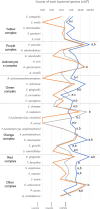Lactobacillus acidophilus impairs the establishment of pathogens in a subgingival multispecies biofilm
- PMID: 39916904
- PMCID: PMC11797891
- DOI: 10.3389/fdmed.2023.1212773
Lactobacillus acidophilus impairs the establishment of pathogens in a subgingival multispecies biofilm
Abstract
The present study evaluated the antibiofilm effects of Lactobacillus acidophilus within a subgingival multispecies biofilm. Lactobacillus acidophilus (La5) at 1 × 102, 1 × 104, and 1 × 106 were included at the beginning of biofilm formation, which lasted 7 days. The biofilms comprised 33 periodontitis-related bacterial species and the Calgary Biofilm device was used. At the end, DNA-DNA hybridization (checkerboard) was performed. A Kruskal-Wallis test followed by a Dunn post hoc test were performed (p ≤ 0.05). La5 at 1 × 104 and 1 × 106 reduced the total counts of biofilm and the proportions of red and green complexes when compared to the control biofilm without La5 (p ≤ 0.05). La5 at 1 × 104 increased the proportions of Actinomyces complex compared to the controls (p ≤ 0.05). Both La5 at 1 × 104 and 1 × 106 decreased levels of 20 and 14 distinct species, respectively, including Porphyromonas gingivalis, Prevotella intermedia, Fusobacterium nucleatum polymorphum, and Parvimonas micra compared to the control (p ≤ 0.05). Only La5 at 1 × 104 reduced the levels of Tannerella forsythia, Fusobacterium periodonticum, and Aggregatibacter actinomycetencomytans compared to the control (p ≤ 0.05). L. acidophilus inhibited establishing periodontic pathogens from red complex such as P. gingivalis and T. forsythia in a subgingival multispecies biofilm.
Keywords: Lactobacillus acidophilus; bacteria; periodontitis; probiotics; subgingival biofilm.
© 2023 Bueno, Dudu-Silva, Macedo, Gomes, Rodrigues Oliveira Braga, Aguiar Silva and Bueno-Silva.
Conflict of interest statement
The author BB-S declared that they were an editorial board member of Frontiers, at the time of submission. This had no impact on the peer review process and the final decision. The remaining authors declare that the research was conducted in the absence of any commercial or financial relationships that could be construed as a potential conflict of interest.
Figures




Similar articles
-
Metabolic activity of hydro-carbon-oxo-borate on a multispecies subgingival periodontal biofilm: a short communication.Clin Oral Investig. 2021 Oct;25(10):5945-5953. doi: 10.1007/s00784-021-03900-0. Epub 2021 Mar 28. Clin Oral Investig. 2021. PMID: 33774716 Free PMC article.
-
Fusobacterium Species and Subspecies Differentially Affect the Composition and Architecture of Supra- and Subgingival Biofilms Models.Front Microbiol. 2019 Jul 30;10:1716. doi: 10.3389/fmicb.2019.01716. eCollection 2019. Front Microbiol. 2019. PMID: 31417514 Free PMC article.
-
Endodontic-Like Oral Biofilms as Models for Multispecies Interactions in Endodontic Diseases.Microorganisms. 2020 May 6;8(5):674. doi: 10.3390/microorganisms8050674. Microorganisms. 2020. PMID: 32384777 Free PMC article.
-
Influence of obesity on subgingival microbiota composition in subjects with different periodontal status: a systematic review.Rev Cient Odontol (Lima). 2024 Mar 30;12(1):e187. doi: 10.21142/2523-2754-1201-2024-187. eCollection 2024 Jan-Mar. Rev Cient Odontol (Lima). 2024. PMID: 39015311 Free PMC article. Review.
-
Orally Administered Probiotics Decrease Aggregatibacter actinomycetemcomitans but Not Other Periodontal Pathogenic Bacteria Counts in the Oral Cavity: A Systematic Review and Meta-Analysis.Front Pharmacol. 2021 Aug 6;12:682656. doi: 10.3389/fphar.2021.682656. eCollection 2021. Front Pharmacol. 2021. PMID: 34447307 Free PMC article. Review.
References
LinkOut - more resources
Full Text Sources
Molecular Biology Databases

